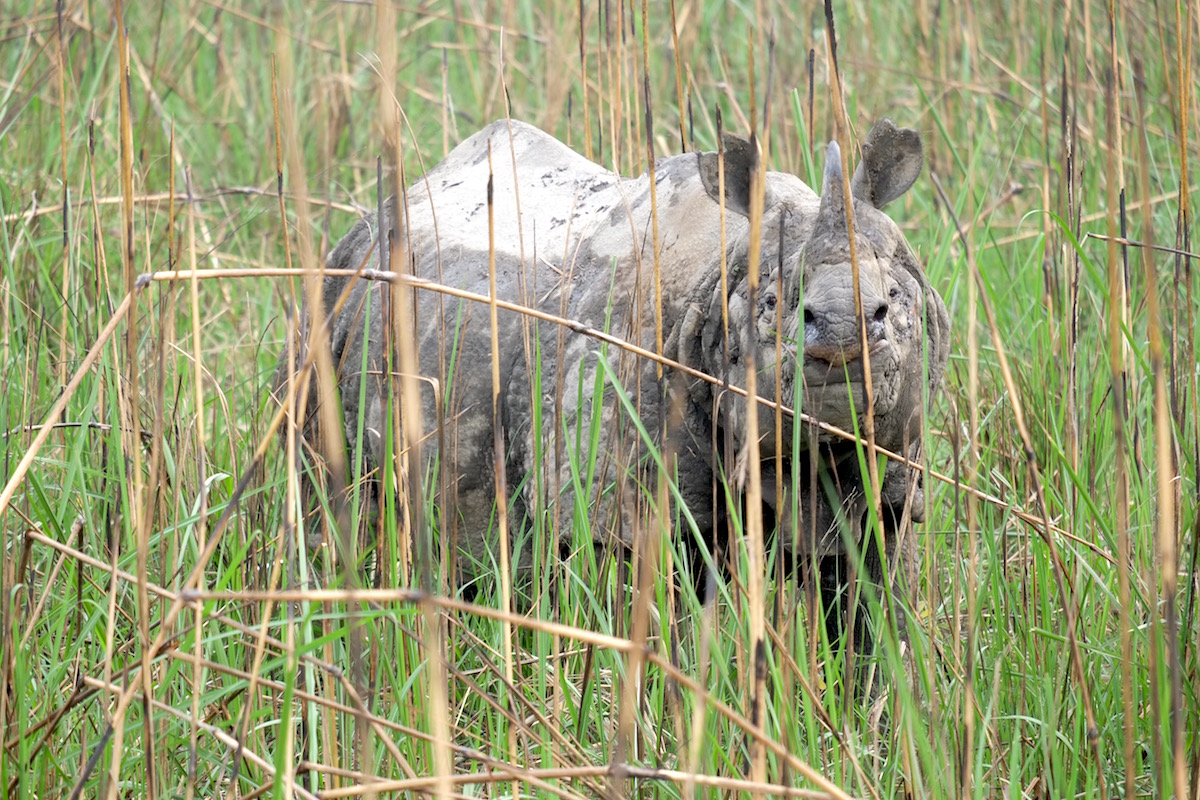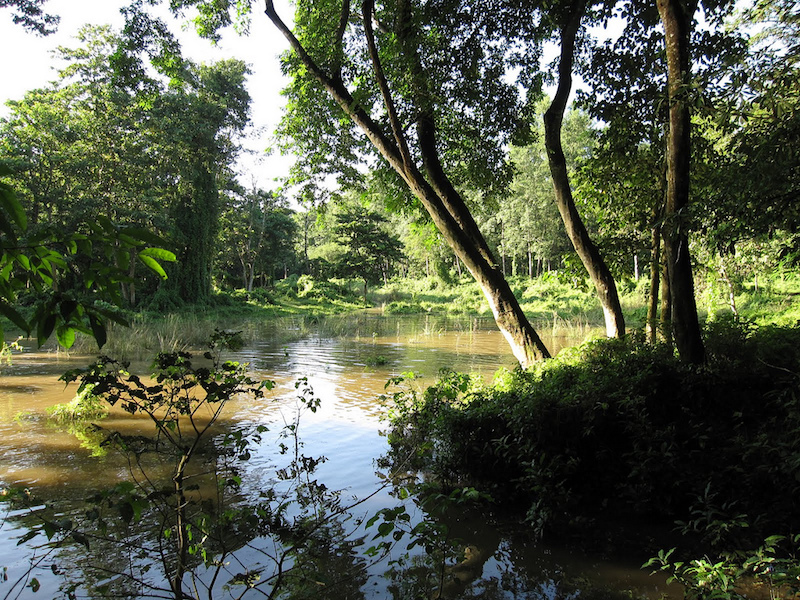When it comes to rhino conservation, Asia and Africa can learn a lot from each other
- Alex Dudley

On June 14, a routine scanning of baggage at Johannesburg’s OR Tambo Airport revealed a grim contraband. A Vietnamese citizen’s suitcase contained 28.7 kilograms (63.3 pounds) of poached rhino horns worth an estimated $462,000 on the black market. The shocking discovery came only three days after two Chinese nationals were detained at the same airport with $385,000 worth of the same deadly cargo.
These busts demonstrate the risk and difficulty smugglers accept when attempting to traffic rhino horn from Africa to distant Vietnam and China — and the immense profit motive that drives this illicit trade. Yet ironically, the prevalence of complex intercontinental poaching networks in Africa highlights how skillfully one Asian country far closer to the horn markets has protected its own rhinos.
Since 2011, only four greater one-horned rhinos (Rhinoceros unicornis) are known to have been poached for their horns in Nepal, while the country’s overall rhino population has grown by 21 percent. This contrasts dramatically with the more than 5,500 black and white rhinos (Diceros bicornis and Ceratotherium simum) slaughtered in South Africa alone over the same period, and the recent poaching uptick elsewhere on the continent. As African nations fight to stem the tide of poaching, they have increasingly sought to understand, and replicate, Nepal’s stunning success.

Figuring out what works
Observers attribute Nepal’s gains to a combination of top-down law enforcement and the economic enfranchisement of rural communities outside the national parks containing rhinos.
While Nepalese army troops patrol against poaching inside the parks, the surrounding buffer zones facilitate a mixture of sustainable cattle-grazing, safari tourism and thatch grass and firewood collecting. Critically, a 1995 law mandates that buffer zone communities receive half the revenue generated from entry permits to Chitwan National Park, which holds the country’s largest rhino population. Although some NGOs criticize these policies for falling short of allowing full and effective participation by local communities, the changes in the law have strengthened the linkage between villagers and wildlife and given local people a direct financial stake in safeguarding rhinos.
It wasn’t always this way. Nepal’s parks began with a strict protectionist approach. Upon the creation of Chitwan in 1973, around 20,000 villagers were evicted, and the park neglected community involvement. “We started out conservation with the guns, because the [rhino] population was gunned,” recalled Naresh Subedi, an officer of Nepal’s National Trust for Nature Conservation (NTNC) in an interview in Kathmandu, commenting on the deployment of army troops in Chitwan in 1975.
These patrols, and the extension of the park from 400 to 1,332 square kilometers (~155 to 515 square miles), helped raise the country’s rhino population from about 100 individuals in the 1970s to almost 600 by 2000, according to Subedi. Meanwhile, recognition of the need for a second population led to the translocation of 70 rhinos from Chitwan to the more remote Bardia National Park between 1986 and 2002.
However, amidst the upheaval of the 1996-2006 Maoist insurgency in Nepal, the redeployment of army troops from the park provided an attractive environment for rhino poaching. Chitwan’s population fell from 500 animals to 370. As Bardia District witnessed some of the worst violence of the conflict, poachers slaughtered nearly all of the park’s rhinos, including all the translocated individuals. After the war, Nepalese conservationists realized the importance of local involvement in securing the survivors.
At the same time that army patrols resumed within the parks and translocations from Chitwan to Bardia recommenced, the NTNC also promoted the deployment of voluntary youth patrols in the buffer zones to support the park authorities. “If somebody’s coming from the outside, [the youth patrols] scrutinize and observe the situation, and they report immediately if they find something wrong,” Subedi commented. “So that checks people [who] are going rhino poaching.” In this regard, Nepal branched from a strictly militarized anti-poaching policy to a more holistic and equitable approach.
Sharing the benefits of conservation
Likewise, a number of African rhino states have recently sought to allow local people to participate in, and prosper from rhino conservation.
Many African parks originated in the late colonial period and sought to exclude pastoralists such as the Maasai from tarnishing “pristine” landscapes. The independent African states continued these exclusionist policies, depriving rural villagers of key grazing or agricultural land and much of the parks’ revenue.
But following the decimation of rhino numbers across East and Southern Africa and the extinction of entire national populations during the 1970s and 80s, conservationists in the remaining strongholds recognized the need for grassroots empowerment.
“Especially from Africa, what the Asian countries can learn is, how do you use wildlife to improve [the] livelihoods of local communities?” Shubash Lohani, Director of Sustainable Landscapes at WWF, said in an interview in Washington D.C. “I think that African countries have been doing it in a much better way than a lot of the Asian countries, like wildlife-based tourism and deriving benefits to the local communities.”
“There is a lot we can learn from African countries in terms of increasing the level of benefits and distributing to the local communities,” Lohani added.
One of the most striking parallels with Nepal’s model can be observed in Namibia, a key stronghold of the black rhinoceros. As in Nepal, rhino populations suffered heavy losses from poaching during the 1966-1990 armed struggle for liberation from apartheid South Africa. But once Namibia gained independence and shifted to black majority rule in 1990, the government recognized the importance of boosting wildlife populations on communal lands. These areas contained most of the country’s rural population but boasted few natural resources other than wildlife, which had been devastated by poaching and over-exploitation.
In 1996, Namibia instituted the policy of rural conservancies registered and administered by communities, who would then receive limited rights to subsistence or tourist trophy-hunting, or safari tourism on their lands, and unconditionally receive 100 percent of the resulting profits. At the same time that these conservancies have generated tourism revenue and skills training for communities, their wildlife populations have risen dramatically.
“I think that [Namibia] is one of the bright spots in Africa where the number of wildlife has been increasing and it’s not only the number of wildlife but also the benefits that people are deriving from wildlife that have been increasing,” Lohani said. “The number of conservancies is growing, so this is a fascinating example of how people and wildlife can coexist and it doesn’t have to be at the expense of each other.”
In particular, Namibia’s northwestern Kunene region has become a haven for the world’s largest free-ranging black rhino population. From only 66 individuals in 1982, the most recent census in 2003 revealed 142. Here as in Nepal’s Bardia Park, rhinos have been translocated to an area where they had nearly been exterminated, and herdsmen closely monitor against poaching.
Recalling the youth patrols in Chitwan’s buffer zones, the Rhino Ranger Incentive Program offers advanced rhino monitoring and field equipment to participating community members, who even receive performance-based cash advances. Communities further profit from the unique opportunity offered to tourists at certain safari camps to track black rhinos on foot, a more intimate experience than viewing wildlife from the confines of a vehicle.
Despite the dramatic contrast between the rocky desert where Namibia’s black rhinos roam and the lush floodplains that shelter Nepal’s greater one-horns, the same basic conservation principles have demonstrated similar success. In both countries, the revenue generated from rhinos compels communities to value live individuals more than dead ones.
In African countries or parks where communities have not adequately benefited from safari tourist revenue, poaching has remained stubbornly high. This disconnect is demonstrated with the failure of militarized anti-poaching efforts to stem the loss of 520 rhinos in Kruger National Park, the epicenter of South Africa’s carnage, in 2013 alone.
“I went to Kruger… and found that the people are not so much involved in conservation,” NTNC Executive Director Ganga Jung Thapa reflected in an interview in Kathmandu. “It is really the park staff. The local people are not really involved in the conservation aspect.”
Seeking to rectify this imbalance, the recent deployment of the Black Mamba Anti-Poaching Unit, comprised of women from communities outside Kruger, has demonstrated early success in stemming poaching. However, a 2016 sociological study of poachers and local residents outside Kruger revealed persisting mistrust toward the park among neighboring villages. The local perception that wild rhinos are valued more than rural black lives has encouraged poaching and frustrated cooperation between villagers and park authorities.
Yet when top-down political commitment to conservation is combined with local participation, African states hold promise of replicating Nepal’s anti-poaching success. Thanks to heightened security and outreach to surrounding pastoralists, Kenya’s famed Lewa Conservancy has not seen any rhino poaching since 2012. Meanwhile, in Kenya as a whole, the integrated National Black Rhino Conservation and Management Strategy (NBRS) has led to steady population growth.
From a low of 300 animals when the Kenyan Wildlife Service (KWS) launched the NBRS in 1985, the country now boasts 696, including the third largest black rhino population after South Africa and Namibia, according to Bas Huijbregts, GEF Global Reduction Coordinator at WWF. In the long run, KWS envisions at least 2,000 black rhinos in Kenya’s national parks, community conservancies, and private ranches,
Both Kenya and Nepal’s success is owed to “Government ownership and a whole-of-government approach, with the government in the driving seat and civil society partners, together with private sector and communities, in a support role,” Huijbregts said in an email.

Experts say that despite Nepal’s success at eradicating poaching, Africa has more successfully promoted its wildlife riches to foreign tourists. Moreover, if East and Southern Africa could also curtail poaching, rhinos there would have a much larger geographic area to recolonize than in South Asia due to far lower human population density.
Lohani noted that Africa also offers the advantage of savanna landscapes that facilitate easier wildlife sightings than densely vegetated Asian rhino habitats like Chitwan. But he added that, “If we do promote or market [wildlife] in the right way, just adding that element of suspense and element of adventure, I think it will still be a very attractive destination for wildlife lovers, and that’s something that Asian countries can learn from Africa.”
Such skillful promotion of rhinos in order to generate revenue is illustrated dramatically in Tanzania’s Ngorongoro Crater. The world’s largest unflooded caldera (volcanic crater), Ngorongoro tempts tourists with the assurance of easy wildlife sightings in a confined area. Beyond its burgeoning herds and predator densities, Ngorongoro boasts the distinction of Tanzania’s last stronghold for free-ranging black rhinos, with about 30 today inhabiting the Crater. As one of the safari industry’s much-touted “big five” animals, any rhino spotted in the Crater soon attracts a large convoy of vehicles jockeying for a view.
As in Nepal, critics argue that tourism revenue in Ngorongoro has tended to benefit Tanzanian elites and entrepreneurial classes in the tourism industry more than local indigenous communities. Yet unlike the country’s national parks, the Ngorongoro Conservation Area allows local Maasai to live alongside wildlife, including grazing their cattle. The absence of rhino poaching in the area over the last two decades suggests that both local residents and Tanzania’s tourism industry recognize the need to safeguard the animals.
Little data currently exists about the economic benefits of rhino conservation. However, Huijbregts noted that research on the effects of elephant poaching on African economies offers a useful comparison. According to a recent study, the ongoing ivory poaching crisis has cost African countries around $25 million in lost tourism revenue annually. “As with elephants in Africa, it seems that investment in rhino conservation is economically favorable across the majority of [the] African rhino range,” Huijbregts said.
Of the more than half a million tourists who visit Ngorongoro Crater annually, generating $3.7 million in revenue, many come specifically hoping to see a black rhino. In fiscal year 2014-2015, Chitwan attracted 172,425 visitors, earning $2.4 million. That half the park’s revenue reaches the buffer zone communities clarifies the economic value of rhino tourism in Nepal.
Despite the different cultural dynamics and vast geographic distance between Nepal and African rhino states, the fusion of top-down anti-poaching enforcement with community participation appears to hold the key to preserving rhinos in both.
“It’s fascinating how geographically so distant and culturally so different regions can have…similar kinds of issues and the approaches to address those issues could be so similar,”Lohani said. “There is a lot that Asia can learn from Africa, and Africa can learn from Asia.”
Source : Mongabay





Feedback